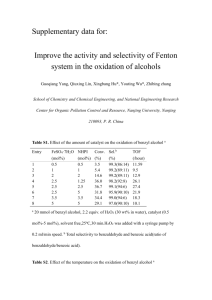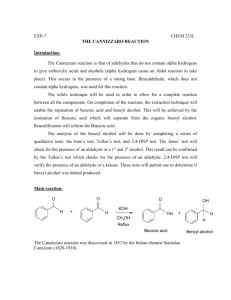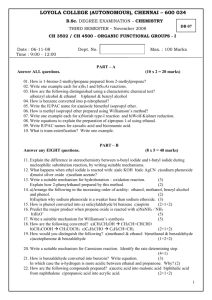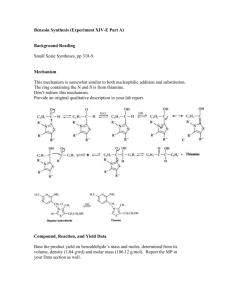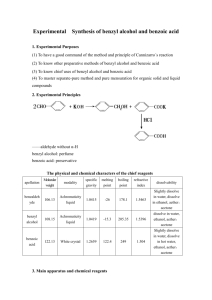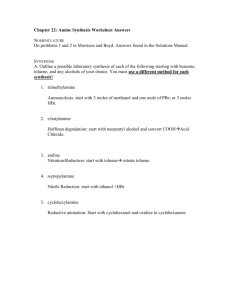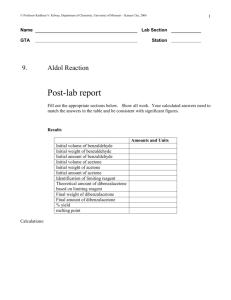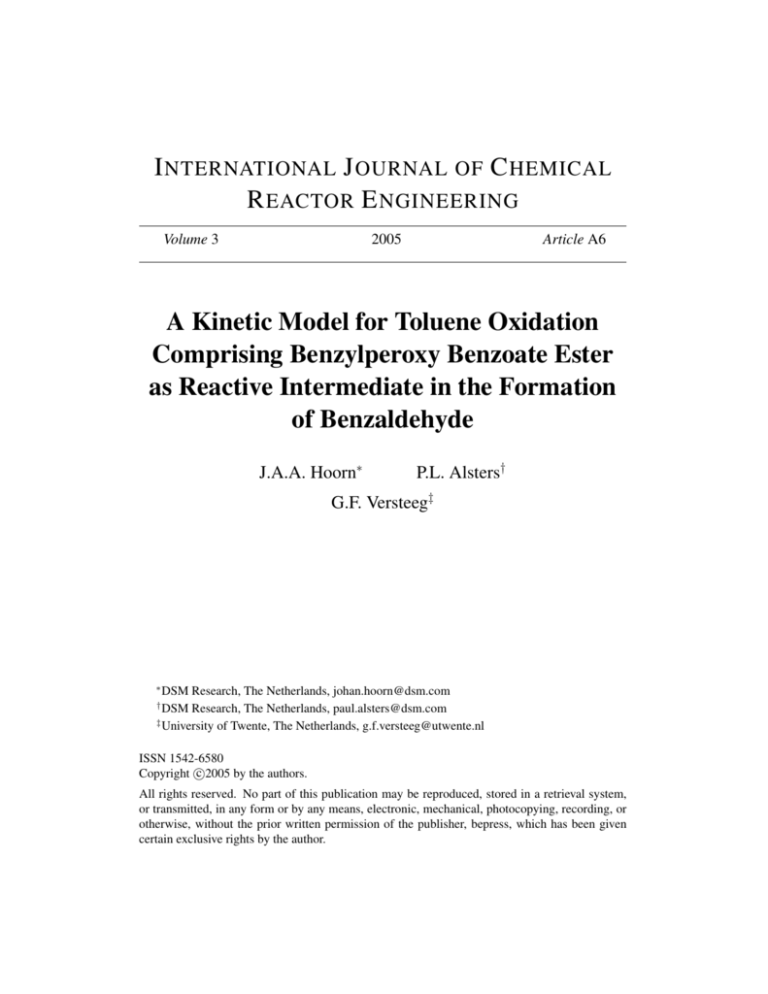
I NTERNATIONAL J OURNAL OF C HEMICAL
R EACTOR E NGINEERING
Volume 3
2005
Article A6
A Kinetic Model for Toluene Oxidation
Comprising Benzylperoxy Benzoate Ester
as Reactive Intermediate in the Formation
of Benzaldehyde
J.A.A. Hoorn∗
P.L. Alsters†
G.F. Versteeg‡
∗
DSM Research, The Netherlands, johan.hoorn@dsm.com
DSM Research, The Netherlands, paul.alsters@dsm.com
‡
University of Twente, The Netherlands, g.f.versteeg@utwente.nl
†
ISSN 1542-6580
c
Copyright 2005
by the authors.
All rights reserved. No part of this publication may be reproduced, stored in a retrieval system,
or transmitted, in any form or by any means, electronic, mechanical, photocopying, recording, or
otherwise, without the prior written permission of the publisher, bepress, which has been given
certain exclusive rights by the author.
A Kinetic Model for Toluene Oxidation Comprising
Benzylperoxy Benzoate Ester as Reactive
Intermediate in the Formation of Benzaldehyde
J.A.A. Hoorn, P.L. Alsters, and G.F. Versteeg
Abstract
During the oxidation of toluene under semibatch conditions, the formation of
benzyl alcohol is initially equal to the rate of formation of benzaldehyde. As the
overall conversion increases the benzyl alcohol concentration at first decreases
much faster than benzaldehyde, but this decrease slows down causing the benzyl alcohol concentration to reduce to zero only very slowly. To account for this
phenomenon a new reaction pathway has been proposed where the formation of
benzaldehyde out of benzylhydroperoxide is catalysed by benzoic acid. Incorporation of this new reaction in a model improves the description of benzyl alcohol
concentration prophiles while maintaining good predictions for benzaldehyde and
benzoic acid.
KEYWORDS: benzoic acid, autoclave, radicals, network, mechanism
Hoorn et al.: An Improved Kinetic Model for Toluene Oxidation
1
1. INTRODUCTION
Toluene oxidation is a reaction system in which chemistry, kinetics, thermodynamics, transport processes and
hydrodynamics interact in a complex fashion. Although the initial development of the process took place already
more than 50 years ago (Palmer and Bibb, 1942; Hearne et al., 1951) and a lot of details have been published
(Keading et al., 1965; Mulkay and Rouchoud, 1967; van Goolen and van den Berg, 1967), there is still room for
improvement especially in the area of integration of the aforementioned disciplines. As an integrating tool,
modelling is very suitable to perform that task. Early model developments have in common that the main focus is on
the kinetics and that other process items are not considered. The interaction of the mass transfer of oxygen with the
toluene oxidation reactions has been addressed by Hoorn et al. in a recent paper (Hoorn et al., 2005). In order to
develop a model suitable for combination with more detailed mass transfer phenomena the kinetic mechanism is
simplified to interactions between the basic components. The simplest model possible is derived from the overall
reaction stoichiometry (Figure 1).
It has to be noted that the
expressions for the reaction rates of
benzaldehyde
benzoic acid
the above model were generated on
1
basis of a best-fit procedure during
parameter estimations. In particular
toluene
4
the oxygen dependence in the
expressions, i.e. first order is in
2
contrast with the general view on
benzyl alcohol
autoxidation reaction rates: zero-th
order with respect to oxygen
concentration (Helferrich, 2001).
However, with the implementation
Bald + H2O
R1 = k12 [Tol] [O2]
1 Tol
+
O2
of the mass transfer rate of oxygen
2 Tol
Balc
R2 = k12 [Tol] [O2]
+ ½ O2
substantially improved results were
obtained
when
the
oxygen
3 Bald + ½ O2
BzA
R3 = k3 [Bald] [O2]
concentration was incorporated in
4 Balc + ½ O2
R4 = k4 [Balc] [O2]
Bald + H2O
the equations. Other model
parameters than those for the
Figure 1. Basic model kinetic scheme
kinetic rate constants have been
estimated using literature correlations. The values for the specific surface area were estimated with the correlation of
Shridhar and Potter (1980), diffusion coefficients were estimated with the correlation of Wilke-Chang (1955). Mass
transfer coefficients were calculated for water with the equation of van ‘t Riet (1979). To translate the mass transfer
coefficients from water at ambient conditions to toluene at reactor conditions, it was assumed on basis of the
penetration theory from Higbie (1935) that the mass transfer coefficient varies with the square root of the diffusion
coefficient as shown in Equation (1).
3
k L ( toluene, 150 oC )
=
k L ( water , 25 oC )
D( toluene, 150 oC )
D( water , 25 oC )
(1)
The reactor models have been programmed in Aspen Custom Modeler. The equations are given in
Appendix 1. Within Aspen Custom Modeler a least squares method is applied to minimize the differences between
experimental values and model calculations. The parameters for this basic kinetic model have been determined in an
experimental set-up comprising a reactor/condenser system operated in a continuous mode (Hoorn et al., 2005). This
is suitable for testing under industrial conditions, but not optimal for kinetic parameter estimations. To validate the
model under different conditions a number of experiments have been performed in a semibatch laboratory autoclave.
In these experiments oxygen was the only reactant that was supplied continuously.
Published by The Berkeley Electronic Press, 2005
International Journal of Chemical Reactor Engineering
2
Vol. 3 [2005], Article A6
2. EXPERIMENTAL
A Parr autoclave is used for toluene oxidation experiments. The reactor set-up comprises a batch liquid and a
continuous gas phase. The Parr autoclave has a volume 250 ml, is equipped with a mechanical stirrer and has a
sample device. The autoclave is equipped with a reflux condenser of sufficient capacity with respect to the heating
power of the reactor jacket. The reflux rates are fairly high in a typical experiment. Application of a cold trap after
the condenser shows that the amount of condensable components passing through the reflux condenser is very little
compared to the total liquid content. A scheme is shown in Figure 2.
vapor out
vapor flow
cooling
condensate flow
The temperature for the experiments was in
the range of 155 – 165 °C and the total pressure in
the autoclave was kept constant at 7 bar. Air was
applied as gas feed. The oxygen concentration in the
off-gas flow was kept below 8 vol% for safety
reasons. Five experiments were performed at a gas
flow of 50 Nl/hr. Oxygen concentrations were
typically in the range of 2 vol%. The differences in
induction period were taken into account by taking
the initial increase in temperature in the liquid as the
starting time of the reaction.
The estimations of kinetic parameters were
performed by a least squares minimization
procedure. The objective function was the sum of
the weighted differences between model and
experimental observed mass fractions in the liquid
heating
for the components benzyl alcohol, benzaldehyde
air supply
and benzoic acid. Toluene was not included in the
objective
function
because
the
toluene
concentrations were not analysed but derived from
Figure 2. Principles of toluene oxidation in Parr autoclave
the mass balance. The weights of the experimental
values for the mass fractions were determined by a
combination of methods. The weight for benzyl alcohol was fixed at a value of 1, the benzaldehyde weight was
adjusted to 0.8 on basis of the (average) slightly higher mass fractions. The weight for benzoic acid was determined
by trial and error; the results of several estimated parameter sets with varying benzoic acid weights showed that best
results were obtained with a value of 0.2.
The statistical output of the results is given as sums of the squared residuals of model prediction and
experimental values (SSR). Also the sum of squared observations (SSO) are given as reference for the SSR. These
definitions and as well as the standard deviation of data are given in Appendix 1. The standard deviations for
parameters are the variances as calculated by the standard procedure provided by Aspen Custom modeler
(covariance matrix calculation from Jacobian and Hessian matrices of the objective function and the parameters).
http://www.bepress.com/ijcre/vol3/A6
Hoorn et al.: An Improved Kinetic Model for Toluene Oxidation
3
3. RESULTS
The results from 5 runs with identical settings are listed in Table 1. The toluene concentration is not analysed but
calculated from the balance.
Table 1. Experimental data
Experiment#
1
2
3
4
5
Time
7
15
27
41
60
79
95
104
9
20
34
49
64
79
98
106
1.25
6.5
9.8
18
44
60.5
89
119
0.5
5.8
10
20
30.25
45
59.8
6.35
12.2
26
45.8
63
BzA
(wt%)
0.10
0.91
3.51
7.28
13.04
21.36
25.72
27.87
0.13
1.63
5.08
9.05
13.49
18.33
23.51
25.93
0.04
0.22
0.64
2.12
9.05
14.01
18.64
29.77
0.00
0.04
0.33
1.95
4.43
8.57
12.09
0.14
0.66
3.76
9.21
14.57
Balc
(wt%)
0.54
1.41
1.70
1.26
0.78
0.78
0.83
0.82
0.58
1.33
1.04
0.85
0.69
0.59
0.57
0.58
0.19
0.84
1.29
1.46
0.74
0.51
0.41
0.34
0.02
0.46
0.96
1.34
0.98
1.19
0.61
0.64
1.27
1.39
0.59
0.47
Bald
(wt%)
0.51
1.28
2.07
2.59
2.49
2.20
2.10
2.04
0.60
1.70
2.41
2.40
2.41
2.33
2.17
2.13
0.14
0.70
1.25
1.86
2.60
2.49
2.34
2.03
0.03
0.53
1.07
1.98
2.48
2.29
2.46
0.49
1.19
2.36
2.68
2.41
Published by The Berkeley Electronic Press, 2005
International Journal of Chemical Reactor Engineering
4
Vol. 3 [2005], Article A6
With the basic model the simulation results for benzaldehyde and benzoic acid are in good agreement with
experiments. The description for benzyl alcohol was not satisfying, it proved not to be possible to qualitatively
describe the "camel hump" in the concentration of benzyl alcohol as is shown in Figure 3.
1.8
benzyl alcohol (wt%)
1.6
1.4
1.2
1
0.8
0.6
0.4
0.2
0
0
20
40
60
80
100
120
tim e (min)
Figure 3. Model prediction versus experimental values
for benzyl alcohol, basic model
The results presented in Figure 3
clearly suggested that some adaptation on
the basic model was required to improve
the model prediction for benzylalcohol.
One of the possible routes was to change
the reaction order coefficients and modifiy
the reaction rate expressions, for example
to a more flexible power law. This option
was not preferred because the relation of
power law expressions to chemical or mass
transfer effects is difficult to make. In
other words, power law models are not
convenient when kinetic expressions are to
be derived from chemical principles.
Instead, it was preferred to extend the
basic model with an effect that occurs
preferentially at higher conversions. To
identify possible reaction pathways where
such effects can occur (part of) the toluene
oxidation reaction network is explained in
the next section.
4. TOLUENE OXIDATION REACTION NETWORK
Bukharkina and Digurov (2004) published a comprehensive review on the field of the kinetics and chemistry on
liquid-phase oxidations. This field can be subdivided into three main systems: metal catalysed oxidation in nonpolar solvents, oxidation in acetic acid as solvent and oxidation in presence of bromide catalysts. Each of the
reaction systems has a number of particular properties, but all systems have in common that the reactions proceed
through radical intermediates. These radical reactions are part of a network comprising initiation, propagation and
termination steps. In addition, non-radical reaction steps also can occur.
4.1. Initiation
Chain-initiating benzyl radicals are generated from toluene by cobalt(III) through one-electron oxidation (Morimoto
and Ogata, 1967) as shown in Equation (2).
PhCH3 + Co3+
PhCH2• + Co2+
+ H+
(2)
Peroxides in general are considered as radical initiation sources. The decomposition of peroxides is catalysed by
cobalt(II)/cobalt(III) in a Haber-Weiss redox cycle (Helfferich, 2001), Equation (3) and (4).
PhCH2OOH + Co3+
PhCH2OO•
+ Co2+
+
H+
(3)
PhCH2OOH + Co2+
PhCH2O•
+ Co3+
+
OH-
(4)
The role of cobalt in the autoxidation of toluene and related components is not limited to these reactions (Scott and
Chester, 1972; Kagami, 1968). More examples of cobalt interactions are given in the next paragraphs
http://www.bepress.com/ijcre/vol3/A6
Hoorn et al.: An Improved Kinetic Model for Toluene Oxidation
5
4.2. Propagation
Independent of the specific reaction system, all mechanisms presented in literature comprise a diffusion controlled
oxygen-coupling reaction with benzyl radical to form a peroxy radical (Bhattacharya et al., 1973; Quiroga et al.,
1980; Gadelle and Clément, 1968; Korthals Altes and van den Berg, 1966; Ivanov et al., 1983) as shown in
Equation (5).
PhCH2•
PhCH2OO•
+ O2
(5)
This peroxy radical can substract hydrogen from any suitable substrate but most often it will be from toluene or
benzaldehyde (Equation (6) and (7)). Similar reactions also occur with the benzoyl radical instead of the benzyl
radical as shown in Equations (8) to (10).
PhCH2OO•
+ PhCH3
PhCH2OOH + PhCH2•
(6)
PhCH2OO•
+ PhCH(O)
PhCH2OOH + PhC•(O)
(7)
PhC•(O)
+ O2
PhC(O)OO•
(8)
PhC(O)OO• + PhCH3
PhC(O)OOH
+ PhCH2•
(9)
PhC(O)OO• + PhCH(O)
PhC(O)OOH
+ PhC•(O)
(10)
The formed perbenzoic acid takes part in the oxidation of benzaldehyde to benzoic acid (Baeyer-Villiger reaction,
see next paragraph). Perbenzoic acid can also be decomposed to benzoic acid by Co(II) through an overall reaction
described by Hendriks et al. (1978a), see Equation (11).
PhC(O)OOH
+ 2 Co2+
+ 2 H+
2 Co3+
+ H2O
+ PhC(O)OH
(11)
Some other radicals are also involved in transfer reactions producing a stable product, for example the reaction of
benzyloxy radical (formed in the initiation reactions) substracts hydrogen from toluene or benzaldehyde to form
benzyl alcohol, Equation (12) and (13).
PhCH2O•
+ PhCH3
PhCH2OH + PhCH2•
(12)
PhCH2O•
+ PhCH(O)
PhCH2OH + PhC•(O)
(13)
4.3. Termination and Sequential Reactions
Experiments on toluene oxidation are mostly carried out with high oxygen concentrations in the gas phase. The
reaction rate of C-centered radicals with oxygen is in general very fast. Traces of oxygen in the liquid decrease the
concentration of C-centered radicals drastically. For these reasons termination products from C-centered radicals
such as benzyl radicals only occur at very low oxygen pressures.
The primary termination reaction proceeds according to a Russell mechanism (1957) between two benzylperoxy
radicals forming oxygen, benzyl alcohol and benzaldehyde (Equation(14) and Figure 4).
2 PhCH2OO•
PhCH(O)
+
PhCH2OH + O2
(14)
Published by The Berkeley Electronic Press, 2005
International Journal of Chemical Reactor Engineering
6
O
CH2OO•
O
H
H
Vol. 3 [2005], Article A6
O
O
2
PhCH(O) + PhCH2OH + O2
H H
Figure 4. Russell mechanism for benzylperoxy radical termination reaction
The oxidation of benzaldehyde to benzoic acid is a Baeyer-Villiger type reaction. In Figure 5 it is shown that
perbenzoic acid oxidizes benzaldehyde forming two benzoic acid equivalents (Hendriks et al., 1978b).
O
OOH
C
H
O
HO
+
O
O
H
O
COOH
2
Figure 5. Baeyer-Villiger reaction
Formation of benzaldehyde from benzylhydroperoxide proceeds through a Co(II)/Co(III) cycle as shown in
Equations (15) and (16).
PhCH2OOH + Co3+
PhCH2OO•
+
Co2+
+
H+
(15)
PhCH2OO•
PhCH(O)
+
Co3+
+
OH-
(16)
+ Co2+
A pathway involving a hydrogen abstraction from the benzylic position of benzyl alcohol under the influence of
Co(III) also accounts for benzaldehyde formation. The radical intermediate ("center-OH radical") reacts with oxygen
to form an peroxy hydrate which decomposes in turn to hydrogen peroxide and benzaldehyde (Figure 6).
PhCH2OH
+
•
PhCHOH
Co3+
H
•
PhCHOH + O2
Co2+
+
OO•
H
RH
H+
OOH
OH
OH
+
- H2O2
PhCH(O)
R•
Figure 6. Oxidation of benzyl alcohol to benzaldehyde
To summarize the (main) reactions pathways, a simplified scheme is presented in Figure 7. All secundairy
transformations that occur in multiple reactions such as the cobalt oxidations or reductions and the hydrogen
abstraction reactions have not been taken into account in the scheme for clarity purposes.
http://www.bepress.com/ijcre/vol3/A6
Hoorn et al.: An Improved Kinetic Model for Toluene Oxidation
7
PhC(O)OH
PhCH(O)
O2
PhCH2•
PhCH2OO•
PhC(O)OOH
•
PhCHOH
•
PhC(O)
PhC(O)OO•
PhCH2OOH
PhCH3
PhCH2O•
O2
PhCH2OH
Figure 7. Reaction network for toluene oxidation showing main reactions
Only a fraction of the reaction rates of the reactions mentioned in Figure 7 are known. In a series of papers
by Howard and Ingold reaction rates for a variety of alkyl aromatic compounds have been determined (1967). The
developments on the estimation of reaction rate constants through molecular modelling are very promising but still
not that accurate for predicting the pre-exponential factors (van Speybroeck and Meier, 2003). The number of
reactions studied in detail is also quite limited still. The reactions shown in Figure 7 have no indication for a
decreased formation or increased reaction of benzyl alcohol at higher conversions. The primary component formed
at high conversion is benzoic acid. It is postulated here that benzoic acid reacts with benzylhydroperoxide to form an
intermediate peroxyester (Figure 8).
CH2OOH
COOH
+
H
O
O
H
O
+
H2O
Figure 8. Formation of benzylperoxy benzoate ester
The peresterification is followed by a decomposition to form benzaldehyde and benzoic acid. The postulated sixmembered transition state of the perester decomposition strongly resembles the commonly accepted transition state
for the Baeyer-Villiger type of rearrangement shown in Figure 9:
H
O
O
H
O
H
COOH
O
+
Figure 9. Formation of benzaldehyde by benzylperoxy benzoate ester decomposition
In this way the formation of benzaldehyde will have a dependency on the benzoic acid concentration, i.e. as the
reaction progresses the rate of benzaldehyde formation will be increased relative to that of benzyl alcohol. Note that
benzoic acid effectively acts as a catalyst for benzylhydroperoxide dehydration to benzaldehyde, since it is
regenerated in the peroxyester decomposition step.
Published by The Berkeley Electronic Press, 2005
International Journal of Chemical Reactor Engineering
8
Vol. 3 [2005], Article A6
5. EXTENDED MODEL
To incorporate the concept of a peroxyester intermediate benzylhydroperoxide (peroxide) and its radical equivalent
are added to the basic kinetic scheme (Figure 10).
d
benzaldehyde
peroxide
a
1
toluene
c
b
peroxy radical
3
benzoic acid
4
c
benzyl alcohol
Per•
R1 = k1 [Tol] [O2]
Per
Per•
Ra = ka [Per]
b
Per•
Per
Rb = kb [Per•]
c
2 Per•
Balc + Bald + O2
Rc = kc [Per•]
d
Per
Bald
Rd = kd [Per] [BzA]
3
Bald + ½ O2
BzA
R7 = k7 [Bald] [O2]
4
Balc + ½ O2
Bald + H2O
R6 = k6 [Balc] [O2]
1
Tol
a
+
O2
+ H 2O
Figure 10. Extended model kinetic scheme
The naming of the rate constants in comparison to the basic scheme in Figure 1 has been kept identical as
much as possible. The rate constants that are involved in equations comprising reactive intermediates have been
designated letters instead of numbers because these constants will be simplified later.
To eliminate the reactive intermediates from the rate expressions, no distinction is made between initiation
and termination rates on one hand and propagation rates on the other hand (which is commonly applied in reducing
radical networks (Helfferich, 2001) because several components are involved in both radical and non-radical
reactions. Instead, the peroxy radical and peroxide concentrations are eliminated with an overall steady-state
assumption, see Equation (17) and (18).
peroxy radical:
R1 + Ra = Rb + 2 Rc
(17)
peroxide:
Rb = Ra + Rd
(18)
In order to reduce the number of parameters, it is also assumed that the radical reactions (a) and (b) are
much faster than the other reactions. The peroxy radical and the hydroperoxide maintain in equilibrium throughout
the reaction progress. On basis of Equations (17) and (18), it is not difficult to derive equations for Rc and Rd in
which the intermediates have been eliminated (see Appendix 2). The explicit expressions for Rc and Rd allow all
component reaction rates to be expressed as functions of observable concentrations:
Rc =
k1 [ Tol ] [ O2 ]
2 + k 2 [ BzA ]
(19)
Rd =
k 1 k 2 [ BzA ] [ Tol ] [ O2 ]
2 + k 2 [ BzA ]
(20)
http://www.bepress.com/ijcre/vol3/A6
Hoorn et al.: An Improved Kinetic Model for Toluene Oxidation
9
6. COMPARISON OF THE MODELS
1.8
1.8
1.6
1.6
1.4
1.4
benzyl alcohol (wt%)
benzyl alcohol (wt%)
The modified reaction rate expressions after optimising the kinetic parameters improves the benzyl alcohol
description indeed substantially as is shown in Figure 11 (Right side). The comparison of the results generated by
the two models is shown in graphical form in Figures 11-14. The values for the kinetic parameters of the two models
are given in Table 2 and 3. The interval values in Table 3 are the standard deviations. The correlation matrices show
how much the parameters dependent on each other. The statistics on the data points and the goodness-of-fit are
given in Table 4.
1.2
1
0.8
0.6
0.4
0.2
1.2
1
0.8
0.6
0.4
0.2
0
0
0
20
40
60
80
100
120
0
20
40
tim e (m in)
60
80
100
120
tim e (m in)
3
3
2.5
2.5
benzaldehyde (wt%)
benzaldehyde (wt%)
Figure 11. Model prediction (line) versus experimental values (symbol) for benzyl alcohol concentration as function
of reaction time. Left: basic model. Right: extended model
2
1.5
1
0.5
2
1.5
1
0.5
0
0
0
20
40
60
tim e (m in)
80
100
120
0
20
40
60
80
100
120
tim e (m in)
Figure 12. Model prediction (line) versus experimental values (symbol) for benzaldehyde concentration as function
of reaction time. Left: basic model. Right: extended model
Published by The Berkeley Electronic Press, 2005
International Journal of Chemical Reactor Engineering
35
35
30
30
25
25
benzoic acid (wt%)
benzoic acid (wt%)
10
20
15
10
5
Vol. 3 [2005], Article A6
20
15
10
5
0
0
0
20
40
60
80
100
120
0
20
40
tim e (m in)
60
80
100
120
tim e (m in)
100
100
95
95
90
90
toluene (wt%)
toluene (wt%)
Figure 13. Model prediction (line) versus experimental values (symbol) for benzoic acid concentration as function of
reaction time. Left: basic model. Right: extended model
85
80
75
85
80
75
70
70
65
65
60
60
0
20
40
60
80
100
120
0
20
40
60
tim e (m in)
80
100
120
tim e (m in)
Figure 14. Model prediction (line) versus experimental values (symbol) for toluene concentration as function of
reaction time. Left: basic model. Right: extended model
Table 2. Kinetic parameters basic model
Parameter values
k12
k3
k4
0.018 ± 0.002
1.52 ± 0.15
1.93 ± 0.20
l/mol/s
l/mol/s
l/mol/s
Correlation matrix
k12
k12
1
k3
0.99
k4
0.96
k3
k4
1
0.95
1
Table 3. Kinetic parameters extended model
Parameter values
k1
k2
k3
k4
0.020 ± 0.002
0.051 ± 0.022
0.87 ± 0.06
0.65 ± 0.08
l/mol/s
l/mol
l/mol/s
l/mol/s
Correlation matrix
k1
k2
k1
1
k2
-0.12
1
k3
0.97
-0.07
k4
0.46
-0.92
http://www.bepress.com/ijcre/vol3/A6
k3
k4
1
0.40
1
Hoorn et al.: An Improved Kinetic Model for Toluene Oxidation
11
Table 4. Statistical output for both models
Component
Benzyl alcohol
Benzaldehyde
Benzoic acid
Weight
1
0.8
0.2
0
Toluene
Statistic1)
SSO
SSR
SDD
SSO
SSR
SDD
SSO
SSR
SDD
SSO
SSR
SDD
Experimental data
30.6
Basic model
Extended model
3.33
0.31
1.79
0.23
3.01
0.24
2.28
0.21
66
0.28
79
0.31
536
-
661
-
139
6056
270213
1) SSO = Sum of Squared Observations, SSR = Sum of Squared Residuals, SDD = Standard Deviation of Data
7. DISCUSSION
The estimation of kinetic parameters on the batch autoclave experiments has been successful for both model
versions, but the extended model with benzoic acid concentrations in the reaction rate expressions gives a better
qualitative and quantitative description of the benzyl alcohol concentrations. Also with regard to the description of
benzaldehyde the extended model has a slightly better performance than the basic model as can be seen from the
statistical values in Table 4. The differences are not very substantial however; comparing the ratio of the sum of
squared residuals and the sum of squared observations the improvement for benzaldehyde is a decrease from 1.3%
to 0.9% in favour of the extended model. The benzoic acid concentration is better described by the basic model. The
changes are not very substantial as can be verified by the visual comparison of Figure 13 and Figure 14. For both
models it is observed that the concentrations for benzaldehyde appear to be somewhat lower than the experimental
values. By changing the weights for the different datasets in the parameter estimation procedure it is possible to
improve the description for benzaldehyde by a few percent but at the same time the good fit for benzyl alcohol is
lost. Extension of the number of experiments and increasing the variation in the reaction conditions should be the
strategy to improve the model in this respect.
The extended model includes a peresterification of benzylhydroperoxide and benzoic acid as an important
step in order to describe the kinetic behaviour of benzyl alcohol properly. This assumption is reasonable, since
peroxyesters can be prepared through condensation of a hydroperoxide with carboxylic acid (Sanchez and Meyers).
Other models, such as those described by Bukharkina and Digurov (2004), appear to be able to describe the kinetics
of benzyl alcohol properly. Unfortunately, the lack of details with respect to their model and experimental
conditions precludes a more accurate comparison with our extended model.
Five experiments with identical conditions provide a useful estimation of the accuracy of the results. As can
be seen from Figure 12 and Figure 13 the spread in the benzyl alcohol values is larger than the benzaldehyde
percentages. This is caused by a combination of factors. The concentrations for benzyl alcohol are a factor 2 lower
than benzaldehyde after the initial reaction period. Benzyl alcohol is also more difficult to analyse accurately than
benzaldehyde. A third reason is the involvement of benzyl alcohol in side reactions such as esterfication with
benzoic acid to benzyl benzoate.
Published by The Berkeley Electronic Press, 2005
International Journal of Chemical Reactor Engineering
12
Vol. 3 [2005], Article A6
Although the limited number of and variation in experiments make it impossible to estimate a larger
number of kinetic parameters, it is questionable whether all kinetic parameters of a reaction network presented in
Figure 7 can be determined on the basis of experiments alone. The most promising route to manipulate complex
reaction networks appears to be a synthesis of experiments and molecular modelling. One of the major challenges is
to maintain the balance between the number of parameters and the predictive quality of the model. At the same time
it is very much desired to increase the number of significantly determined parameters at the lowest experimental
effort.
On the basis of the theoretical correlations it was found that the high rotational speed of the autoclave
stirrer and the small liquid volume gave high values for the mass transfer coefficient, making the exact value for
mass transfer coefficient not very critical. In a previous investigation (Hoorn et al., 2005) it was found that the
oxidation of toluene is a slow reaction with respect to mass transfer. In combination with a sufficiently high oxygen
concentration in the gas phase it can therefore be concluded that the mass transfer for oxygen is not important in
these experimental settings. However, the models are set-up in such a way that also non-ideal conditions can be
described.
8. CONCLUSIONS
In a batch operated autoclave the benzyl alcohol concentrations are initially increasing equally fast as benzaldehyde.
As the oxidation of toluene progresses, the benzyl alcohol concentration diminishes faster in comparison with
benzaldehyde, but the benzyl alcohol concentration approaches zero only very slowly at longer reaction times. In
order to describe this behaviour by means of a model a dependency on the benzoic acid concentration is suggested.
Through the hypothesis that the decomposition of benzylhydroperoxide to benzaldehyde is catalysed by benzoic
acid the formation rate of benzaldehyde is increased relative to benzyl alcohol at higher benzoic acid concentrations.
Through estimation of the kinetic parameters the modifications in the model indeed improve the description of the
benzyl alcohol concentration profiles observed during the oxidation of toluene.
http://www.bepress.com/ijcre/vol3/A6
Hoorn et al.: An Improved Kinetic Model for Toluene Oxidation
13
NOTATION
c
F
k
kPflow
kVflow
kLa
m
Mr
n
nobs
npar
P
R
V
w
x
y
Ycalc
Yexp
concentration in liquid phase, mol/l
flow, mol/s
kinetic rate constant, 1/s or l/mole/s
constant for controlling flows, mol/bar/s
constant for controlling flows, mol/l/s
volumetric liquid side mass transfer coefficient, s-1
mass in liquid phase, g
molar mass, g/mol
number of moles, mol
number of observations, number of parameters, pressure, bar
reaction rate, mol/l/s
volume, l
weight factor for estimation, mole fraction in liquid phase, mol/mol
mole fraction in gas phase, mol/mol
calcultated variable, observed variable, -
Greek
density, mol/l
fugacity coefficient, Subscripts
i
gas
vap
liq
tot
nv
set
component
vapor phase
vapor phase
liquid phase
total
non-volatiles
set point
Superscripts
in
feed stream
out
exit stream
sat
saturated
Abbreviations
Balc
benzyl alcohol
Bald
benzaldehyde
BzA
benzoic acid
Per
benzylhydroperoxide
Per•
benzylperoxy radical
Tol
toluene
Published by The Berkeley Electronic Press, 2005
International Journal of Chemical Reactor Engineering
14
Vol. 3 [2005], Article A6
REFERENCES
Bhattacharya, D., Guha, D.K., Roy, A.N., "Liquid phase air oxidation of toluene to benzoic acid. II. Kinetics and
mechanism", Chem. Age India, Vol. 24, No. 2, 87-90 (1973).
Bukharkina, T.V., Digurov, N.G., "Kinetics of aerobic liquid-phase oxidation of organic compounds", Org. Proc.
Res. Dev., Vol. 8, 320-329 (2004).
Gadelle, C., Clément, G., "Étude cinétique de l'oxydation radicalaire par l'oxygène des alcoylaromatiques en phase
liquide", Bull. Soc. Chim. De France, Vol. 1, 44-54 (1968).
Hearne, G.W., Evans, T.W., Buls, V.W., U.S. Patent 2,578,654 (Dec. 18, 1951).
Helfferich, F.G., "Kinetics of homogeneous multistep reactions", in "Comprehensive Chemical Kinetics", R.G.
Compton & G. Hancock Eds., Vol. 38, Elsevier, Amsterdam, 283-286 (2001).
Hendriks, C.F., van Beek, H.C.A., Heertjes, P.M., "The oxidation of substituted toluenes by cobalt(III) acetate in
acetic acid solution", Ind. Chem. Prod. Res. Dev., Vol. 17, No. 3, 256-260 (1978a).
Hendriks, C.F., van Beek, H.C.A., Heertjes, P.M., "The kinetics of the autoxidation of aldehydes in the presence of
cobalt(II) and cobalt(III) acetate in acetic acid solution", Ind. Chem. Prod. Res. Dev., Vol. 17, No. 3, 260-264
(1978b).
Higbie, R., "The rate of absorption of a pure gas into a still liquid during short periods of exposure", Trans. Am.
Inst. Chem. Eng., Vol. 35, 36-60 (1935).
Hoorn, J.A.A., van Soolingen, J., Versteeg, G.F., "Modelling toluene oxidation, incorporation of mass transfer
phenomena", Chem. Eng. Res. Des., Vol. 83(A2), 187-195 (2005).
Howard, J.A., Ingold, K.U., "Absolute rate constants for hydrocarbon autoxidation", Can. J. Chem., Vol. 45, 793802 (1967).
Ivanov, S.K., Kalitchin, Z.H.D., Hinkova, M.K., "Direct oxidation of toluene to benzaldehyde in the presence of Nbromosuccinimide", Oxidation Communications, Vol. 3, No. 2, 89-102 (1983).
Kagami, K., "Anomalous effect of the concentration of metal-salt catalysts in the liquid-phase oxdation of p-xylene
and toluene", Bull. Chem. Soc. Jap., Vol. 41, No. 7, 1552-1557 (1968).
Keading, W.W., Lindblom, R.O., Temple, R.G. , Mahon, H.I. "Oxidation of toluene and other alkylated aromatic
hydrocarbons to benzoic acids and phenols", Ind. Eng. Chem. Process Des. Dev., Vol. 4, No. 1, 97-101 (1965).
Korthals Altes, F.W., van den Berg, P.J., "Kinetics of the autoxidation of ethylbenzene", Receuil, Vol. 85, 538-544
(1966).
Morimoto, T., Ogata, Y., "Kinetics of the autoxidation of toluene catalyzed by cobaltic acetate", J. Chem. Soc. (B)
62-66 (1967).
Mulkay, P., Rouchaud, J., "Solvatation des catalyseurs d'oxydation en phase liquide homogène", Bull. Soc. Chim.
Fr., Vol. 12, 4653-4657 (1967).
Palmer, R.C., Bibb C.H., U.S. Patent 2,302,462 (Nov. 17, 1942).
Quiroga, O.D., Gottifredi, J.C., Capretto de Castillo, M.E., "Liquid phase catalytic toluene oxidation, formulation of
a kinetic model", Rev. Latinoam. Ing. Quim. Quim. Apl., Vol. 10, 77-88 (1980).
http://www.bepress.com/ijcre/vol3/A6
Hoorn et al.: An Improved Kinetic Model for Toluene Oxidation
15
Russell, G.A., "Deuterium-isotope effects in the autoxidation of aralkyl hydrocarbons. Mechanism of the interaction
of peroxy radicals", J. Am. Chem. Soc., Vol. 79, 3871-3877 (1957).
Sanchez, J., Meyers, T.N., "Peroxides and peroxide compounds, organic peroxides" in "Kirk-Othmer, Encyclopedia
of chemical technology", John Wiley & Sons, online edition (2004).
Scott, E.J.Y., Chester, A.W., "Kinetics of the cobalt-catalyzed autoxidation of toluene in acetic acid", J. Phys.
Chem., Vol. 76, No. 11, 1520-1524 (1972).
Shridhar, T., Potter, O.E., "Interfacial areas in gas-liquid stirred vessels", Chem. Eng. Sci., Vol. 35, 683-695 (1980).
van Goolen, J.T.J., van den Berg, P.J., "The catalytic oxidation of toluene in the liquid phase", Industrie Chimique
Belge, Vol. 32, 658-661 (1967).
van Speybroeck, V., Meier, R.J., "A recent development in computational chemistry: chemical reactions from first
principles molecular dynamics simulations", Chem. Soc. Rev., Vol. 32 151-157 (2003).
van 't Riet, K., "Review of measuring methods and results in nonviscous gas-liquid mass transfer in stirred vessels",
Ind Eng Chem Process Des Dev, Vol. 18 357-364 (1979).
Wilke, C.R., Chang, P., "Correlation of diffusion coefficients in dilute solutions", AIChE J., Vol. 1, 264-270 (1955).
Published by The Berkeley Electronic Press, 2005
International Journal of Chemical Reactor Engineering
16
APPENDIX 1. MODEL EQUATIONS AND STATISTICAL DEFINITIONS
Kinetics – basic
Kinetics – extended
R1 = k 12 cTOL cO 2
R1 = k 1 cTol cO 2
k c c
Rc = 1 Tol O 2
2 + k 2 c BzA
k k c
c c
Rd = 1 2 BzA Tol O 2
2 + k 2 c BzA
R3 = k 3 c BALD cO 2
R4 = k 4 c Balc cO 2
R2 = k12 cTOL cO 2
R3 = k 3 c BALD cO 2
R4 = k 4 c BALC cO 2
RBALC = R2 R4
R BALD = R1 R3 + R4
RBzA = R3
R H 2O = R1 + R4
1
(R2 + R3 + R4 )
RO 2 = R1
2
RTOL = R1 R2
R Balc = Rc R4
R Bald = Rc + Rd + R4 R3
RBzA = R3
R H 2 O = R d + R4
1
(R3 + R4 )
RO 2 = R1 + Rc
2
RTol = R1
Definitions
mi = nliq ,i M r ,i
mi
mnv
( wt%)i = 100
mnv =
mi
mO 2
mN 2
i
Reactor
For all components i :
gas ,i
yi =
xisat
liq ,i
n gas ,tot yi = n gas ,i
nliq ,tot xi = nliq ,i
ci =
liq
cisat =
xi
sat
i
xisat
out
out
Fgas
,i = y i Fgas ,tot
dnliq ,i
dt
dn gas ,i
= Fliqin,i + k L a Vtot (cisat
dt
in
= Fgas
,i
out
Fgas
,i
ci ) + Vliq Ri
k L a Vtot (cisat
ci )
Other equations :
http://www.bepress.com/ijcre/vol3/A6
Vol. 3 [2005], Article A6
Hoorn et al.: An Improved Kinetic Model for Toluene Oxidation
out
Fgas
,tot =
in
Fgas
,i + k flow
(Ptot
17
Pset ) if Ptot
Pset
out
else Fgas
,tot = 0
i
V gas
= n gas ,tot
gas
Vliq
= nliq ,tot
liq
Vliq + V gas = Vtot
n gas ,tot =
n gas ,i
i
nliq ,tot =
nliq ,i
i
Cooler
For all components i :
gas ,i
yi =
liq ,i
xisat
n gas ,tot yi = n gas ,i
nliq ,tot xi = nliq ,i
ci =
c
sat
i
xi
liq
=
sat
i
xisat
out
out
Fgas
,i = y i Fgas ,tot
Fliqout,i = xi Fliqout,tot
dnliq ,i
dt
dn gas ,i
= k L a Vtot (cisat
in
= Fgas
,i
dt
out
Fgas
,i
ci ) + Vliq Ri
Fliqout,i
k L a Vtot (cisat
ci )
Other equations :
out
P
Fgas
,tot = k flow (Ptot
Fliqout,tot = k Vflow (Vliq
V gas
Vliq
Vset ) if Vliq
Pset
Vset
out
else Fgas
,tot = 0
else Fliqout,tot = 0
= n gas ,tot
gas
liq
Pset ) if Ptot
= nliq ,tot
Vliq + V gas = Vtot
n gas ,tot =
n gas ,i
i
nliq ,tot =
nliq ,i
i
Published by The Berkeley Electronic Press, 2005
International Journal of Chemical Reactor Engineering
18
Statistical definitions:
Sum of Squared Observations,
nobs
SSO =
i =1
Sum of Squared Residuals,
SSR =
nobs
Yexp,i
(Y
nobs
SDD =
Ycalc ,i )
2
exp,i
i =1
Standard Deviation of Data,
2
(w (Y
i =1
i
exp,i
nobs
Ycalc ,i ))
2
n par
APPENDIX 2. SIMPLIFICATION OF REACTION NETWORK
Reaction rate equations:
R1 = k 1 [ Tol ] [ O2 ]
Ra = k a [ Per ]
Rb = k b [ Per • ]
Rc = k c [ Per • ]
Rd = k d [ Per ] [ BzA ]
Steady state assumption on peroxy radical and peroxide:
R1 + Ra = Rb + 2 Rc
Rb = Ra + Rd
Substitution of the expressions for the reaction rates and some rearrangements gives:
[ Per• ] =
[ Per ] =
k 1 (k a + k d [ BzA ] ) [ Tol ] [ O2 ]
2 k a k c + (k b + 2 k c ) k d [ BzA ]
2 ka
k 1 k b [ Tol ] [ O2 ]
k c + (k b + 2 k c ) k d [ BzA ]
These expressions are substituted in the reaction rates Rc and Rd:
Rc =
k 1 k c (k a + k d [ BzA ] ) [ Tol ] [ O2 ]
2 k a k c + (k b + 2 k c ) k d [ BzA ]
Rd =
k 1 k b k d [ BzA ] [ Tol ] [ O2 ]
2 k a k c + (k b + 2 k c ) k d [ BzA ]
When ka and kb are much larger than the other constants the equations for Rc and Rd become:
http://www.bepress.com/ijcre/vol3/A6
Vol. 3 [2005], Article A6
Hoorn et al.: An Improved Kinetic Model for Toluene Oxidation
Rc =
k 1 [ Tol ] [ O2 ]
k k
2 + b d [ BzA ]
ka kc
k1
Rd =
19
kb k d
[ BzA ] [ Tol ] [ O2 ]
ka kc
k k
2 + b d [ BzA ]
ka kc
The parameters ka through kd in these two expressions can be replaced by one independent constant (k2 for naming
convenience) giving the following final expressions for the rate equations:
Rc =
k 1 [ Tol ] [ O2 ]
2 + k 2 [ BzA ]
Rd =
k 1 k 2 [ BzA ] [ Tol ] [ O2 ]
2 + k 2 [ BzA ]
Published by The Berkeley Electronic Press, 2005

